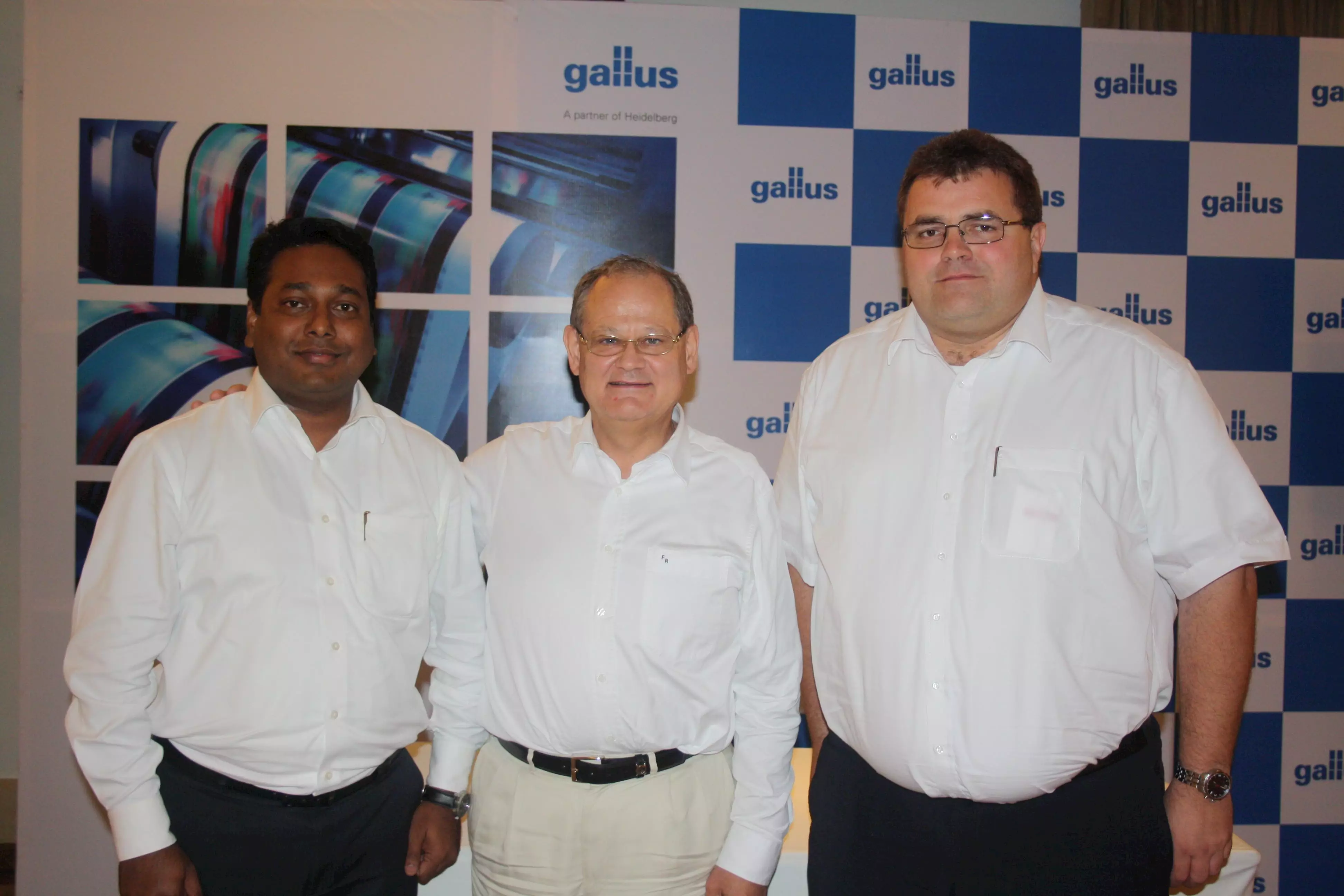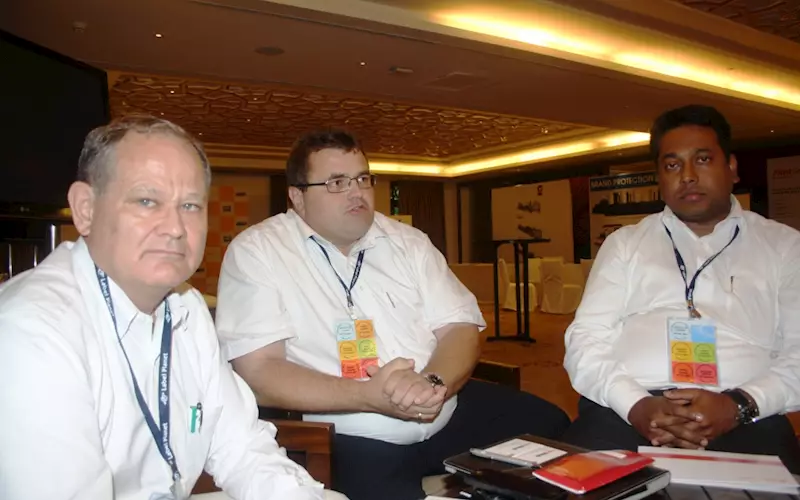Till March 2013, Gallus has crossed 70 installations in India
In an exclusive interview with PrintWeek India, Ruesch Ferdinand (RF) owner and vice chairman Gallus Group and Samir Patkar (SP) managing director Gallus India and Christof Naier (CN) vice president sales and marketing, label business Gallus Group discuss the business strategy in India and Labelexpo Europe 2013 with PrintWeek India's Ramu Ramanathan (RR).
07 Aug 2013 | By Ramu Ramanathan
RR: India is an important market for Gallus?
RF: Yes, for many years now. Samir Patkar has been with us since the Heidelberg days. He has established a good name for us in the Indian market. We have witnessed substantial growth, as our sales team has worked towards it in India. We believe our company having adirect presence in India has helped us stay closer to the customer and address their needs.
RR: What are the number of installations?
SP: Till March 2013, we have crossed 70 installations. A majority of them has been the Gallus EM280s. This model has been a key brand which has been successful for us in India. So I would look at about 55 presses of the EM 280s. We have the EMS line and ECS line. ECS line was launched at the Labelexpo Brussels in 2010. It is the granite press and we have four installs in India. One interesting trend is, that even though the prime number is coming from the EM280 series press, we are witnessing a statistical shift from the EM 280 to the ECS series which is our top of the line series. This is the next technology brand in Gallus Group.
RR: I know it is ancient news, but what has happened with the Gallus and Heidelberg partnership. If you can put to rest the market speculations.
SP: I am not sure about the market speculations. Let me put it this way. We are still partners with Heidelberg. So they still have 30% partnership with the Gallus Group worldwide.Then, there have been various countries where Gallus is on its own. For example, in USA we are Gallus USA, in Australia we are Gallus Australia, in Germany, UK, so even though Heidelberg owns 30%, the distribution in certain markets is handled by Heidelberg and othermarkets, it is handled by Gallus. The basic reason of Heidelberg and Gallus being together was, there are synergies in packaging technologies which is being studied by Heidelberg. In web press, over the years, they have seen a shift from a sheetfed press like SM 52 or SM 74; to label presses which are moving to web operations. This is where the Gallus fits the bill.
RR: In the Asia Pacific region, Gallus has been with Heidelberg since 2000.
SP: After 2009, there have been lot of changes. After the Lehmann Brothers crisis globally I don’t think things have remained the same. Heidelberg has been investing, but at the end of the day, one has limited budgets. Money towards investment because it is not just only on technology, it is also on head count and people. So I believe it was a good way for the both the companies. Gallus looks at these emerging markets. And we need to invest in it. When you form Gallus South East Asia or Gallus South Asia or Gallus China at the end of the day,you need to invest. In today's grim times, if somebody calls to invest money, it is probably Heidelberg. I think, they will continue to invest in core technology. This is why it was mutually decided, that this was the better solution. At the end of the day we still part of the family but we are focused on our individual businesses.
RR: How big is the Gallus India team?
SP: We are nine which includes admin, sales and technical experts to support the 70 presses in India. The challenge is to have skilled team. This was mutually agreed. I was the part of the transition and I can state it was smooth. We work closely with Heidelberg India.
RR: Labelexpo, what is happening on this front?
CN: To begin with, the new partnership with Heidelberg for digital is important to mention. Gallus has taken the responsibility for the sale of Heidelberg’s Lineoprint digital printing system for the label industry.
RR: Will the Lineoprint be available in India?
CN: We have started with seven dedicated regions; as we can’t start worldwide operation. These regions include US, Germany, Poland, France, Italy, Australia etc. Obviously the Lineoprint L will have a prominent space on our stall at the Labelexpo Brussels. This means, all the printing technologies are under one roof for the label printers. Starting with flexo, offset, screen, gravure to digital, we have everything. This is one of the exhibitions showing that Gallus is a partner for the label convertor no matter what he is seeking. We have ‘print job concept’ meaning you have the most efficient machine for printing the job in one way and other way you do the high speed production. For example you do the conventional jobs on flexo and special jobs with variable data on a Heidelberg’s Lineoprint. It is a good combination perfectly integrated. For example you do shampoo labels which has hair colour, face colour, and then there is variable data. The variable data can be done on Lineoprint L while the regular features can be printed on conventional Gallus flexo press.
RR: What are the features on the Lineoprint? We saw it eons ago, and then Heidelberg went silent on it.
CN: They have now improved and technically updated it, which is good. It is successfully launched. We recently installed the first press in Australia. The customer is happy with it.
RR: What is the width and speed of the Lineoprint?
CN: There are three widths starting from, 210, 315 and 420mm and the speed 45 metre per minute. We will come up with a solution where we will combine Heidelberg’s Lineoprint L with aconverting machine from Gallus. This will be done along with the ECS press where the substrate will pass through a Lineoprint L and emerge from the ECS press.
RR: This is the digital component of your presence at Labelexpo. What else?
CN: We have a software, Serve which is the partner of Heidelberg. This software calculates on which press or which way we should produce the job efficiently with all the data handling.
RR: And the presses?
CN: The Gallus ECS which was launched three years ago, is our most successful press. We have sold 160 presses worldwide. We are coming up with a package which makes it more efficient with high production speed a new unit from HMI. So all the future Gallus presses, will get the same look and feel. We will be also showcasing our new unwinder and rewinder, new matrix rewinder, new screen printing system, rail system. Plus there is a new software to reduce the wastage and setup time significantly. We will be showing the Gallus EMS 430 and print unit of Gallus RCS. A week after the show, we will have a small event at our premises in Switzerland to show the full functioning of RCS. Besides all this, we will showcase our Gallus EM280 press which is successfully selling in South East Asia and South Asia at the Labelexpo with a new LED curing system.
RR: Are you bullish about the Indian market?
SP: There are couple of factors. If look at it from the label stock supplies, then according to the label stock manufacturers, it is 400 million sq/mtr market. Most of them are saying, the space is growing at 20%. So if you look at 400 million sq/mtr with 20% growth, we are talking about adding 18 million sq/mtr on a yearly basis. Lot of label convertors over the years have understood the importance of being productive and efficient. We see this is happening. There is tremendous change. If you look at the brand owners, I can tell you most of the companies in various sectors have been growing. FMCG, pharmaceutical, personal care is growing in India.
RR: Is 20% growth unviable? How does Gallus eye this space?
SP: You must be aware that three years ago everyone was reporting double digit growth. This is being scaled down and is further scaled down to 14%. At the end of the day, I feel,relative growth is there. In terms of opportunities, it looks immense because if you look at the segments of FMCG and cosmetics, when you look at the brands at the super markets,most of them good labels, filmic labels. All this is on the rise with lot of value addition. So what’s happening on the top is, there are certain label convertors who are catering to this growth and doing solid business. There is a large segment in the middle of the pyramid who are wanting to enter this space and add to their capacities either on their individual presses which they have already purchased or purchase new presses to cater to this growth. The real challenge is at the bottom - and the transition in the middle. In this space, we see lot of Chinese presses. There is fierce competition in that segment.
RR: Is there a strategic pull which is dependent on pricing?
SP: It is there, and if it is not played smartly, then there will be an issue. Brand owners are getting smarter. Most of them, are getting into reverse auctioning. They are playing it smartly among the printers. When you talk about the reverse auction, you are talking about companies like Levers, P&G, J&J. So it’s only the label convertors on the top who play smart.
RR: Is this the reason, many firms are creating a second unit Baddi or Sikkim?
SP: Yes, two trends, really. One, a lot of acquisitions in India because it is a big concern for the label convertors, since they will need to scale up in order to cope up with the growth. When you are talking about the growth, you are talking about the investment and infrastructure. Some of our converters have been typical mom and pop shops, who operatefrom one place. You need to move out and be in close proximity to the brand owners because brand owners move to various places in India to avail tax benefits. Do I need to go to Baddi or Sikkim? This would add a lot to their investment. So the point is, is he ready for this investment and the challenge? There are lot of factors. It could be father-son, two brothers running the business, if it is run from one place then who is going to handle the other location? Is he ready to employ professionals? These are important questions which needs to be addressed.
RR: What is happening in Europe in terms how the print buying community determining the market?
CN: It is tough because the market is saturated; and so it is very competitive. Even the big players want to drive the cost leadership.
RR: So what happens next with Gallus? I mean the Europeans and it is the crowded market place.
CN: We are focusing on developing the market. So far, we have spoken about the Indian market, but we have founded Gallus Singapore and China. So we are really going to these markets and developing them for Gallus.
RR: Are you looking at manufacturing off-site in a non European territory to cut cost? Is India a destination?
CN: We did look at some of the countries. We believe, we have a high quality product and believe in delivering the same to our customers. We have designed standard based on thequality of our press. We can't compromise on this. So to answer your question, no, we have not planned anything.












 See All
See All